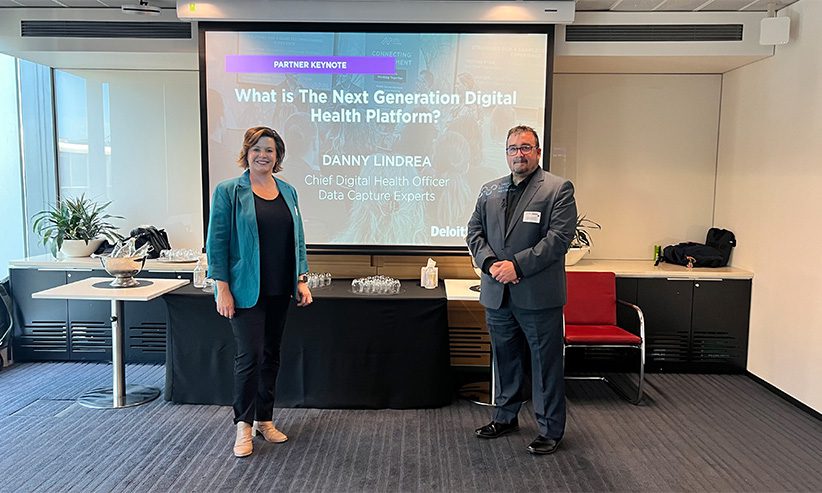(03) 9863 7644


Advancing Connected Healthcare with DC2VUE
Why are we doing digital health alone when collaboration could revolutionise patient care?
In a thought-provoking keynote, Danny Lindrea introduced DC2VUE—a next-generation digital health platform set to transform healthcare beyond the limitations of traditional Electronic Medical Records (EMRs) and Digital Medical Records (DMRs). This presentation challenged the current practices in digital health and emphasised the necessity of a collaborative approach to healthcare innovation.
Challenging the Status Quo
"Why are we all doing digital health on our own?" This critical question highlighted the fragmented nature of existing digital health initiatives. Different organisations are working independently on various aspects such as remote patient monitoring and interoperability. Referencing earlier discussions about the disjointed efforts in digital health, it was clear that a unified, collaborative approach is necessary for significant advancements.
Danny Lindrea: A Journey of Innovation in Healthcare
With 15 years of experience in public health, Lindrea's journey from implementing a patient administration system across 16 hospitals to transitioning from a technologically-limited hospital to a modern, tech-enabled facility provided profound insights. This journey underscored the complexities and challenges of large-scale healthcare IT projects and shaped the vision for DC2VUE.
Connect with Danny Lindrea on LinkedIn
Cloud Adoption and Integration
A pioneering step in the adoption of cloud technology, specifically Microsoft Azure, was undertaken to host clinical workloads. This strategic move aimed to eliminate the need for managing data centres and servers. The cloud's flexibility allowed for rapid trials of new tools, significantly advancing the digital platform. Integration was a key focus, leading to the development of a unified integration engine that connected 16 hospitals, enabling seamless data sharing and collaboration.
Regional Community Platform
One of the standout initiatives was the implementation of a regional community platform in Victoria. This platform standardised community care across 16 hospitals, each maintaining its own database while sharing a common user interface. Overcoming logistical challenges, the project demonstrated that a shared digital health solution could be both practical and effective.
Debunking Healthcare IT Myths
Several prevalent myths in healthcare IT were challenged:
-
No Silver Bullet: Contrary to the belief that healthcare lacks straightforward solutions, it was argued that the right technology and approach could simplify many aspects of healthcare.
-
Fit to Solution: The notion that clinical workflows must adapt to rigid solutions was criticised. Instead, systems should be designed around user needs.
-
Change Management: The necessity of allocating large portions of budgets to change management was questioned. Well-designed consumer-centric solutions can minimise the need for extensive training and adjustment.
Next-Generation Digital Health Platform
The vision for a next-generation digital health platform—a cloud-based, multi-tenant system supporting multiple organisations and care settings—was introduced. Key features of this platform include:
-
Multi-Tenant Architecture: Each organisation maintains its own database while sharing a common frontend, ensuring both data sovereignty and standardisation.
-
Interoperability: Leveraging standards like HL7, FHIR, and APIs to facilitate data exchange while reducing the need for traditional interoperability within the same cloud environment.
-
Security: Utilising the robust security layers of platforms like Microsoft Azure to enhance overall system security.
-
Real-Time Error Checking: Implementing real-time data validation to ensure accuracy and compliance.
Future Models of Care
Innovative models of care that the new platform could support were outlined:
-
Augmented Reality Consultations: Potential for remote consultations using AR technology, enhancing patient and provider interaction.
-
Centralised Referral Services: Streamlining referral management across a unified cloud platform, improving efficiency and patient experience. Shared
-
Resourcing: Enabling resource sharing among hospitals, particularly beneficial in regional areas facing staffing challenges.
-
Virtual Monitoring Hubs: Centralising patient monitoring to efficiently manage care across multiple facilities, ensuring high-quality care and quick response times.
-
Mobile Health Workers: Equipping health workers with mobile tools to access patient information and manage appointments remotely, enhancing their capability to provide care on the go.
Danny Lindrea's keynote concluded with an urgent prompt for Australia's Healthcare leaders to embrace a collaborative approach to digital health, emphasising that sharing resources and integrating systems can lead to significant improvements in efficiency, quality of care, and patient outcomes.
The audience was invited to participate in a brief survey to share their challenges and directed to the company's website for further information.
Embrace the Future of Connected Healthcare
DC2VUE represents a transformative leap in digital health innovation, promising a more connected, efficient, and patient-centric healthcare system. By challenging the status quo and promoting collaboration, DC2VUE is paving the way for a new era in healthcare.
For more information and to participate in our survey, click here.





